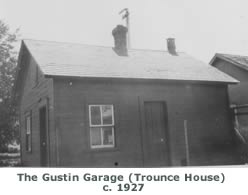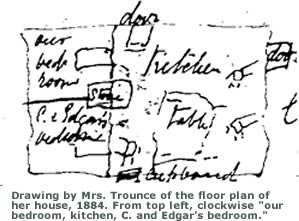About Trounce House

In August, 1882, John Lake and a party of nine men came to the area in which they located the site of the future city of Saskatoon. In the group was James M. Eby who, rather than returning to Eastern Canada, wintered in Prince Albert. His family joined him in Saskatoon the following year. That same year, 1883, the first six houses were built in the new settlement. The sixth one to be built was owned by John Conn but he never lived in it and in 1884 he sold it to the Harry Trounce family which had just arrived from England. They lived in it until 1887 when Mrs. Trounce died in childbirth and Mr. Trounce died a few months later while on a journey to England.
In 1885 the Trounces added a store to the house and thus, except for a temporary store operated out of a tent by John Willoughby, it was the first store in Saskatoon. The sale of the house to Mr. Trounce was also the first real estate transaction in the village. Of the first six houses, only the Trounce House still stands and thus it is the oldest building in Saskatoon.
The Trounces, who were involved in the community's earliest schooling efforts and religious life, contributed very significantly to the cultural and social fabric as well. Their home "was the scene of innumerable social activities, especially parties on Christmas Eve or New Year's Eve, and is referred to in several early memoirs and books. The Trounces were all musical, and their letters document such things as their participation in the 'Sol Fa' singing classes, choir practice, and the organization of charades. . . " (Donald G. Irvine, "Found: The Sixth Building to be Built in Saskatoon (The Trounce House Still Stands Intact on its Original Lot in Nutana)," Saskatchewan History 40:3, p. 89).
After the death of the Trounces, the house was cared for by the executor of the estate and then in 1893 it was sold to Robert W. Caswell. He also operated a store out of it but then moved to Beaver Creek.
In 1920, the lot on which the Trounce House was located was purchased by the Gustins, so that a residence could be built for them with a piano studio for Lyell Gustin. The Trounce House was moved from the front to the back of the lot and was converted into a garage.
Early histories of Saskatoon incorrectly identify other buildings as being the Trounce House. The Gustin garage was never correctly identified, except for a little-known photograph and a caption including information provided by Eliza Eby, printed in a June 1927 special issue of the Daily Star. Eliza Eby was the daughter of the James Eby who came in 1882 and the aunt of Evelyn Eby, one of the more prominent graduates of the Lyell Gustin Piano Studios. In 1927 Eliza Eby recalled attending a Christmas Eve party held 42 years earlier in the house.

It was not until 1987-88 that the Trounce House was properly identified when Don Irvine made a study of historical records, early histories and newspapers, and his findings published in Saskatchewan History. The Trounce Family Papers in the Archives of Saskatchewan provide a very authentic source of information about the Trounce House from 1884 to 1887. One letter includes a sketch of the house showing the location of the furniture in the kitchen-dining room and in the two bedrooms leading off the larger room. When the house was converted into a garage the interior walls were not removed and what plaster and paint which has survived the ravages of time appears to be as it was when the Trounces lived in it.
A debt is owed to Don Irvine for the research done in his study. Not only did he correctly identify a "lost" building but his study was crucial in arousing the interest and concern of the Municipal Advisory Heritage Committee about the fate of the building. This also alerted the Committee to the importance of the Lyell Gustin Piano Studios and ultimately both buildings were declared heritage buildings in By-law No.7024 passed by Saskatoon City Council on April 10, 1989. It is quite unique to have two heritage buildings from two different periods of Saskatoon's history on the same site.
—text adapted from Lloyd Rodwell, 1990

